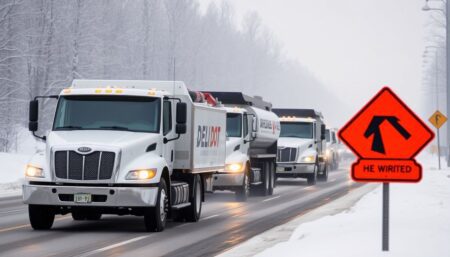Have you ever found yourself wondering what books you should have on hand in case of a sudden power outage, a natural disaster, or even a long-term survival situation? As preppers and survival enthusiasts, we understand the importance of being prepared for any scenario. But with countless survival guides and prepper literature available, it can be overwhelming to decide which resources are truly essential. That’s where this article comes in.
In ‘Building a Survival Library: Essential Books and Resources’, we aim to demystify the process of curating a comprehensive collection of survival literature. We’ll delve into the world of prepper literature, exploring the most valuable survival guides and reference materials that every prepared individual should have in their library. Whether you’re a seasoned prepper or just starting your journey, this article promises to be your ultimate guide to building a survival library that will serve you well in any situation.
But why is having a well-stocked survival library so important? According to a study by the Red Cross, 60% of Americans do not have a household disaster plan, and only 35% have an emergency supply kit. These statistics highlight a significant gap in preparedness, one that a robust survival library can help bridge. Imagine being able to access vital information on first aid, shelter building, or even foraging for food, all from the comfort and safety of your own home. A survival library can be your lifeline to knowledge and self-sufficiency in times of crisis.
So, are you ready to take the first step towards comprehensive preparedness? Let’s embark on this journey together. In the following sections, we’ll explore various categories of prepper literature, from survival guides to reference materials, and discuss why each is crucial for your survival library. We’ll also provide recommendations for the best books in each category, ensuring you have a well-rounded and valuable collection. So, grab a pen, and let’s start building your survival library today!
Navigating Prepper Literature, Survival Guides, and Reference Materials
Embarking on a journey through the vast expanse of prepper literature, survival guides, and reference materials is akin to traversing a well-stocked, albeit somewhat chaotic, library in a post-apocalyptic world. This literary landscape is a treasure trove of knowledge, brimming with wisdom that could one day prove invaluable. From the meticulously researched tomes that delve into the intricacies of wilderness survival, to the more speculative works that explore the potential aftermath of societal collapse, each book offers a unique perspective on how to navigate the unpredictable.At the heart of this genre lies the prepper ethos, a philosophy that advocates for self-reliance and preparedness in the face of potential disasters. These texts are not merely guides on how to start a fire or purify water; they are manuals on how to maintain hope, resilience, and community in the face of adversity. They delve into the psychological aspects of survival, offering insights into how to maintain mental fortitude in trying times.The survival guides, with their practical advice and step-by-step instructions, are the workhorses of this genre. They provide concrete solutions to the myriad challenges one might face in a survival situation, from building shelters to identifying edible plants. Yet, they are not without their philosophical underpinnings. After all, the ability to survive physically is only half the battle; the other half is surviving mentally and emotionally.The reference materials, meanwhile, are the scholars of this literary landscape. They provide in-depth analyses of potential disaster scenarios, from natural disasters to societal collapse. They are the books that delve into the nitty-gritty of emergency medicine, renewable energy, and sustainable agriculture. They are the texts that remind us that while we may not be able to predict the future, we can certainly prepare for it.Navigating this literature is a journey of discovery, a process of learning and unlearning, of questioning and affirming. It is a testament to the human spirit’s capacity for adaptability and resilience. So, whether you’re a seasoned prepper or a curious beginner, delving into these texts is not just about preparing for the worst; it’s about understanding the best of what we can be.
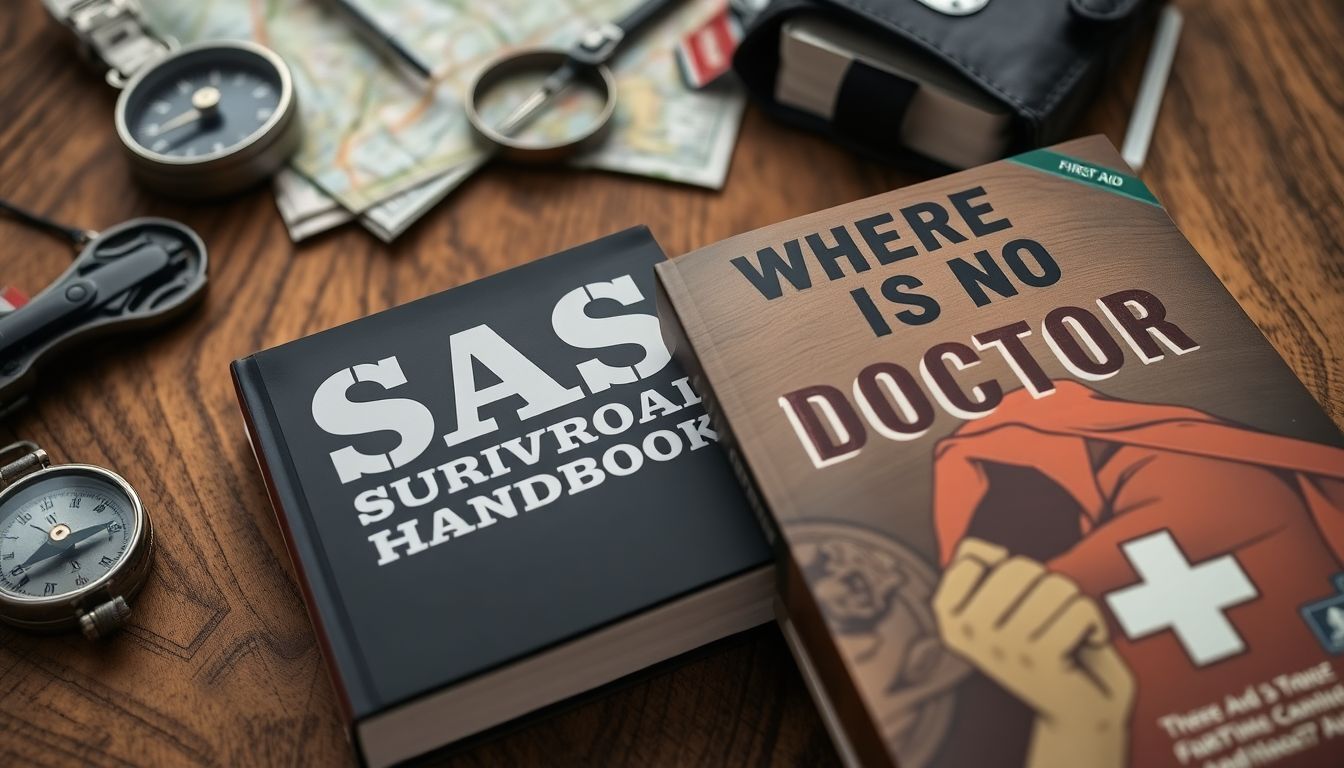
The Foundation: Classic Survival Guides
In the vast expanse of human history, there have been a select few guides that have stood the test of time, offering timeless wisdom and practical skills that remain as relevant today as they were decades, even centuries ago. Among these, ‘The SAS Survival Handbook’ and ‘Where There Is No Doctor’ are two shining beacons of knowledge that continue to illuminate the path for those who find themselves in survival situations.
The SAS Survival Handbook, first published in 1986, is a comprehensive guide to survival in any environment, written by former SAS soldier John ‘Lofty’ Wiseman. It’s a testament to the book’s enduring relevance that its advice on shelter building, fire making, and navigation remains as valuable today as it was when it was first published. The book’s practical approach, with clear illustrations and step-by-step instructions, makes it an invaluable resource for anyone who wants to be prepared for the unexpected.
Similarly, ‘Where There Is No Doctor’, first published in 1970, is a health care manual that has saved countless lives around the world. Written by a team of medical professionals, this guide provides detailed instructions on how to treat a wide range of medical conditions, from minor injuries to life-threatening emergencies. The book’s emphasis on simple, low-cost solutions makes it an essential resource in areas where access to medical care is limited.
Both these guides share a common thread
- they empower individuals with the knowledge and skills they need to survive and thrive in challenging circumstances. They teach us the importance of preparation, adaptability, and self-reliance. They remind us that in the face of adversity, knowledge is power.
In essence, these classic survival guides are not just books; they are roadmaps to resilience. They remind us that while we cannot predict the future, we can certainly prepare for it. And in doing so, we gain not just the ability to survive, but also the confidence to face whatever life throws at us. After all, as the old adage goes, ‘By failing to prepare, you are preparing to fail.’ And these guides are here to help us prepare, and prepare well.
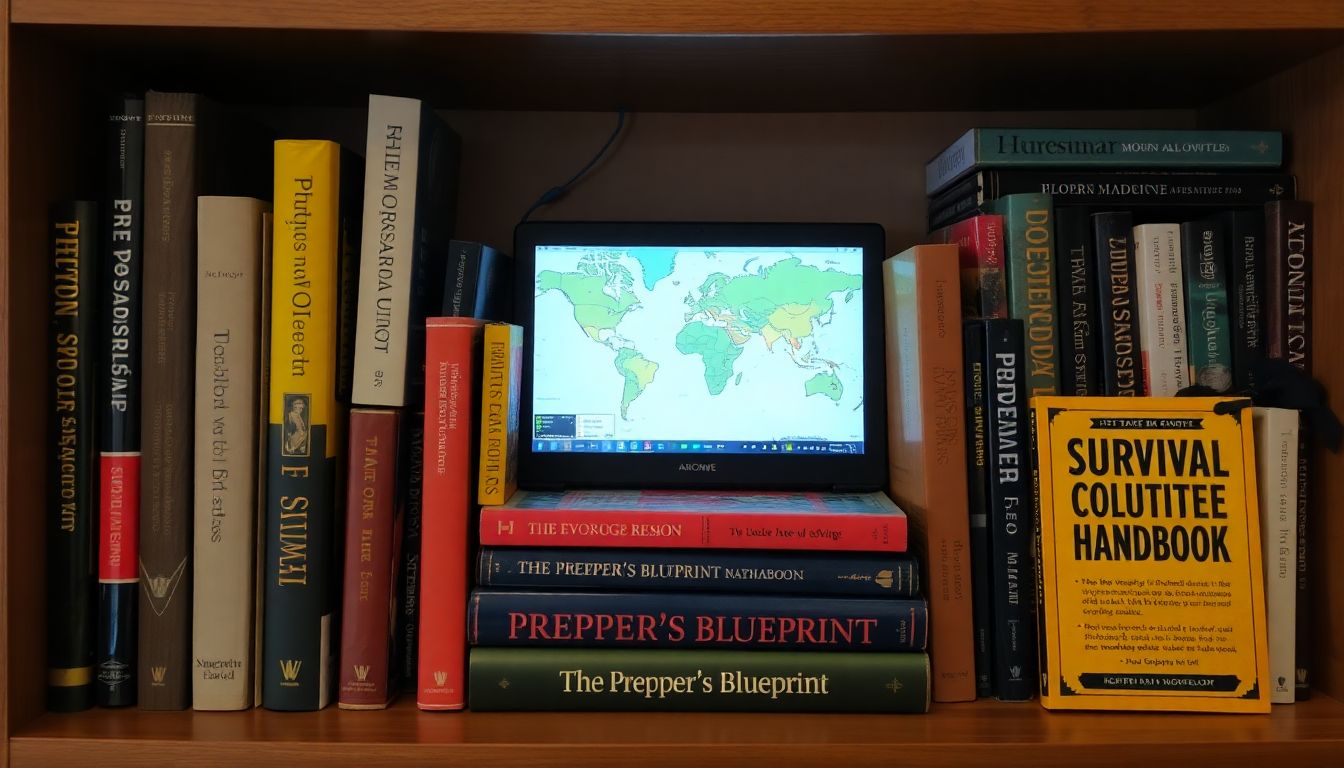
Modern Perspectives: Contemporary Survival Guides
In the ever-evolving landscape of survival literature, contemporary guides have emerged, offering unique perspectives that complement the timeless wisdom of classic survival manuals. Two standout examples are ‘The Prepper’s Blueprint’ by Tess Pennington and ‘The Survival Medicine Handbook’ by Joseph Alton and Amy Alton. Both books approach survival from distinct angles, enriching the broader conversation on preparedness and self-reliance.
‘The Prepper’s Blueprint’ by Tess Pennington is a comprehensive guide that focuses on the practical aspects of survival, with an emphasis on self-sufficiency and sustainability. Pennington’s approach is holistic, covering a wide range of topics from food storage and gardening to alternative energy sources and self-defense. What sets this guide apart is its emphasis on community preparedness. Pennington argues that survival is not just about individual preparedness, but also about building resilient communities. This perspective complements classic guides like ‘The SAS Survival Handbook’ by John ‘Lofty’ Wiseman, which focuses more on individual skills and wilderness survival.
‘The Survival Medicine Handbook’ by Joseph Alton and Amy Alton, on the other hand, is a unique contribution to the survival genre, focusing exclusively on medical aspects of survival. The authors, both medical professionals, provide detailed instructions on treating injuries and illnesses in a disaster situation. This guide is a valuable addition to any survival library, as it fills a gap often overlooked in classic survival guides. While classic guides like ‘Where There Is No Doctor’ by David Werner provide basic medical information, ‘The Survival Medicine Handbook’ delves deeper, offering detailed instructions on procedures like setting fractures and performing surgeries in a survival setting.
Both ‘The Prepper’s Blueprint’ and ‘The Survival Medicine Handbook’ offer valuable insights that complement and expand upon the information provided in classic survival guides. They demonstrate that the field of survival literature is dynamic and evolving, reflecting the changing needs and priorities of modern society. By exploring these contemporary guides, we can gain a more comprehensive understanding of survival, from the practical aspects of self-sufficiency to the critical importance of medical knowledge in a disaster situation.

Medical Knowledge: Essential Reference Materials
In the vast ocean of medical knowledge, certain reference materials serve as lighthouses, guiding both professionals and laypeople through the complexities of health and illness. Two such indispensable beacons are ‘The Merck Manual’ and ‘Where There Is No Dentist’.
‘The Merck Manual’, first published in 1899, is a comprehensive medical textbook that has evolved over the years to become a trusted online resource. It offers a wealth of information on symptoms, diseases, and their treatments, making it an invaluable tool for healthcare providers and patients alike. The manual’s user-friendly interface and detailed yet accessible content enable individuals to understand their health conditions better and engage in informed dialogues with their healthcare providers.
‘Where There Is No Dentist’, on the other hand, is a practical guide designed for use in resource-poor settings. It empowers communities and individuals to provide basic oral health care when dental professionals are not available. The book covers a wide range of topics, from preventing dental problems to managing dental emergencies. It is an excellent example of how medical knowledge can be democratized, making it accessible to those who need it most.
Both these resources emphasize the importance of understanding and treating common ailments without professional help, fostering a sense of self-reliance and empowerment. They are not meant to replace professional medical advice but rather to complement it, promoting health literacy and self-care. In essence, they are not just reference materials; they are tools for empowerment, enabling individuals to take charge of their health and well-being.
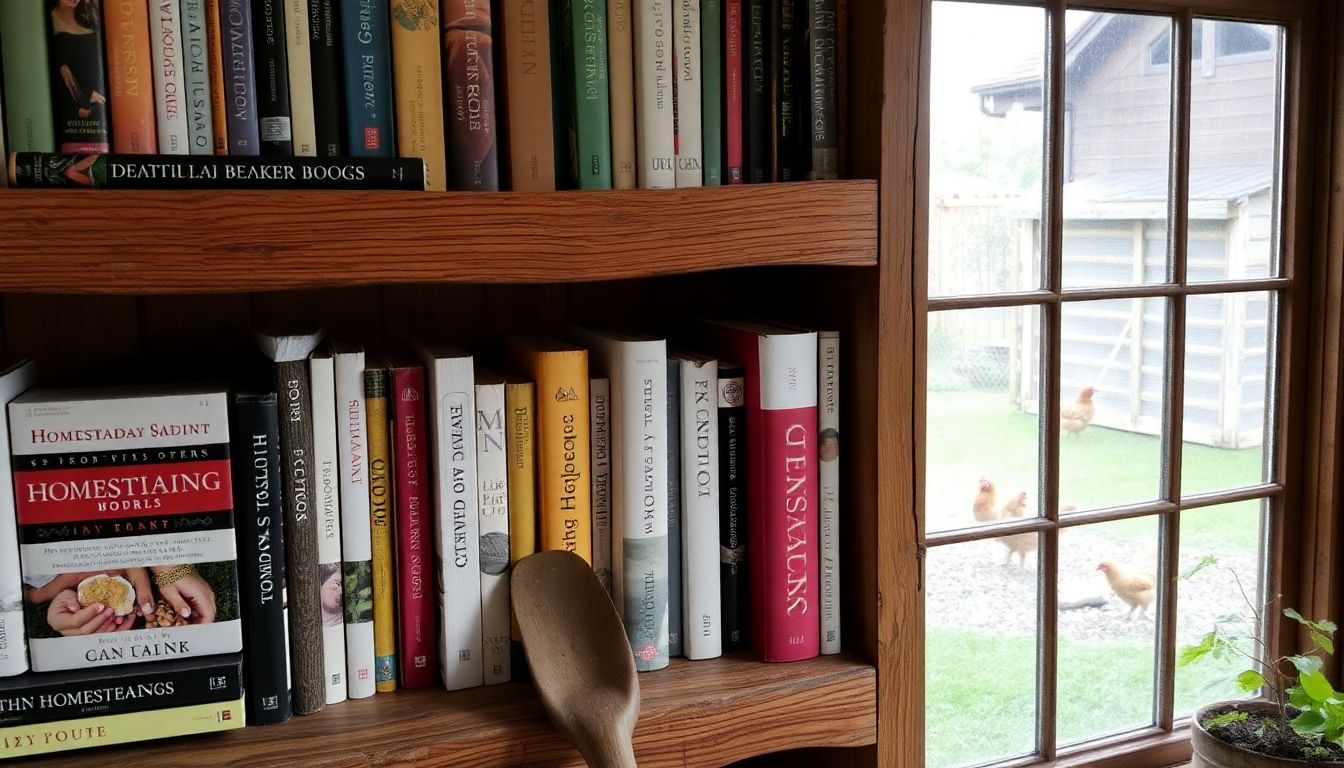
Self-Sufficiency Skills: Homesteading and DIY
Embarking on a journey towards self-sufficiency often begins with a desire to disconnect from the grid and reconnect with nature. Two seminal works that have long been guiding lights for aspiring homesteaders and DIY enthusiasts are ‘The Encyclopedia of Country Living’ by Carla Emery and ‘The Foxfire Book’ by Eliot Wigginton. These books are not just collections of information, but comprehensive roadmaps that can transform readers into competent, self-reliant individuals.
Carla Emery’s ‘The Encyclopedia of Country Living’ is a veritable bible for those seeking to live off the land. Spanning over 800 pages, it covers a vast array of topics, from gardening and animal husbandry to food preservation and natural remedies. Emery’s practical, hands-on approach makes complex subjects accessible, even to beginners. For instance, her detailed instructions on canning and preserving foods ensure that no harvest goes to waste, while her advice on raising chickens and goats provides a solid foundation for those interested in small-scale livestock farming.
‘The Foxfire Book’, on the other hand, is a treasure trove of Appalachian wisdom, preserving the traditional skills and crafts of a people deeply connected to the land. From blacksmithing and weaving to log cabin building and moonshining, the book offers a fascinating glimpse into a way of life that has all but disappeared. Wigginton’s interviews with local experts provide an intimate, personal touch, making the learning experience engaging and inspiring. For those interested in learning to build their own home or craft their own tools, ‘The Foxfire Book’ is an invaluable resource.
Both books emphasize the importance of self-reliance and sustainability, encouraging readers to look beyond the supermarket and the hardware store. They remind us that the skills our ancestors took for granted
- growing food, building shelters, making clothes
- are not only valuable but also deeply satisfying. By learning these skills, we not only gain independence but also cultivate a deeper appreciation for the natural world and our place within it.
So, whether you’re dreaming of a smallholding in the country or simply want to reduce your reliance on store-bought goods, these books offer a wealth of knowledge and inspiration. They are not just guides to self-sufficiency, but also invitations to a more meaningful, connected way of life. So, roll up your sleeves, grab your favorite book, and let the journey begin!
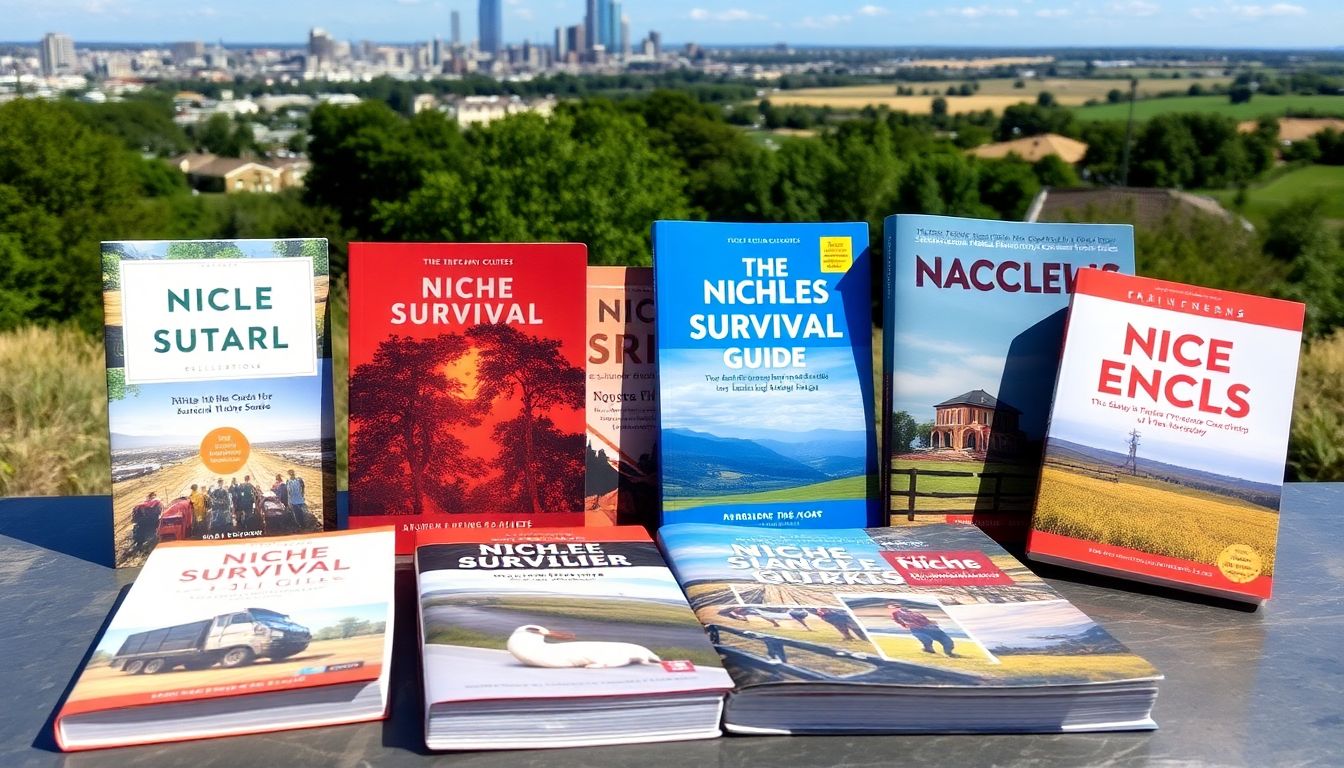
Prepping for Specific Scenarios: Niche Guides
In the vast realm of survival guides, some stand out for their tailored approach to specific scenarios, offering unique insights and practical advice. Take, for instance, ‘When All Hell Breaks Loose’ by Cody Lundin. This urban survival guide is not your typical wilderness survival manual. It’s a no-nonsense, practical guide that focuses on the unique challenges and resources available in urban environments. Lundin, a renowned survival instructor, provides step-by-step guidance on everything from finding water in a city to navigating power outages and even dealing with looters. He emphasizes the importance of ‘sheltering in place’ and turning your home into a fortress, making this guide an invaluable resource for those who live in cities and towns.
On the other end of the spectrum, ‘The Encyclopedia of Country Living’ by Carla Emery offers a wealth of knowledge for those who live off the grid or in rural areas. This comprehensive guide covers everything from gardening and animal husbandry to food preservation and natural remedies. Emery’s approach is holistic and self-sufficient, encouraging readers to rely on their own skills and resources rather than external systems. She provides detailed instructions on how to grow and preserve your own food, raise livestock, and even make your own soap and candles. The guide also includes a wealth of recipes, making it a practical and engaging read.
Both of these guides offer unique insights into their respective scenarios, but they share a common thread: they empower readers to take control of their own survival. They remind us that no matter where we live, we have the power to prepare for the unexpected and to rely on our own skills and resources. Whether you’re a city dweller or a rural resident, these niche survival guides offer a wealth of knowledge that can help you navigate any situation.

Prepper Fiction: Learning Through Storytelling
In the realm of preparedness, often referred to as ‘prepping’, the role of fiction cannot be underestimated. Prepper fiction, a subgenre of post-apocalyptic literature, serves as a unique tool for mental and emotional preparation. Books like William R. Forstchen’s ‘One Second After’ and David Moody’s ‘The Postmortal’ offer readers more than just engaging narratives; they provide immersive experiences that can help individuals navigate complex scenarios and understand the intricacies of survival.
Prepper fiction, at its core, is about storytelling. It weaves tales of ordinary people facing extraordinary circumstances, allowing readers to connect with characters and their struggles on a deeply personal level. This emotional investment is the first step in mental preparation. When we care about the characters, we begin to think about how we would react in similar situations, fostering a sense of empathy and understanding.
These stories also serve as practical guides, albeit in a fictional format. They often delve into the logistics of survival, from food and water procurement to shelter and defense. By presenting these details in a narrative context, prepper fiction makes complex information more accessible and engaging. For instance, ‘One Second After’ explores the aftermath of an electromagnetic pulse (EMP) attack, detailing the challenges and solutions in a way that is both informative and captivating.
Moreover, prepper fiction encourages critical thinking and planning. It forces readers to consider ‘what if’ scenarios and the potential consequences of their actions. This thought process can translate into real-life preparedness, inspiring readers to create their own plans and strategies. It’s a form of mental rehearsal, helping individuals prepare for the unexpected.
Lastly, prepper fiction can provide emotional resilience. It shows characters, and by extension, readers, how to cope with loss, fear, and uncertainty. These stories often depict communities coming together, highlighting the importance of social connections in times of crisis. This emotional understanding can be invaluable when facing real-life challenges.
In essence, prepper fiction is not just about reading; it’s about learning, feeling, and preparing. It’s a unique blend of entertainment and education, offering readers a chance to explore the unknown in the safety of their imagination. So, the next time you pick up a prepper fiction novel, remember, you’re not just reading a story; you’re preparing for the unexpected.
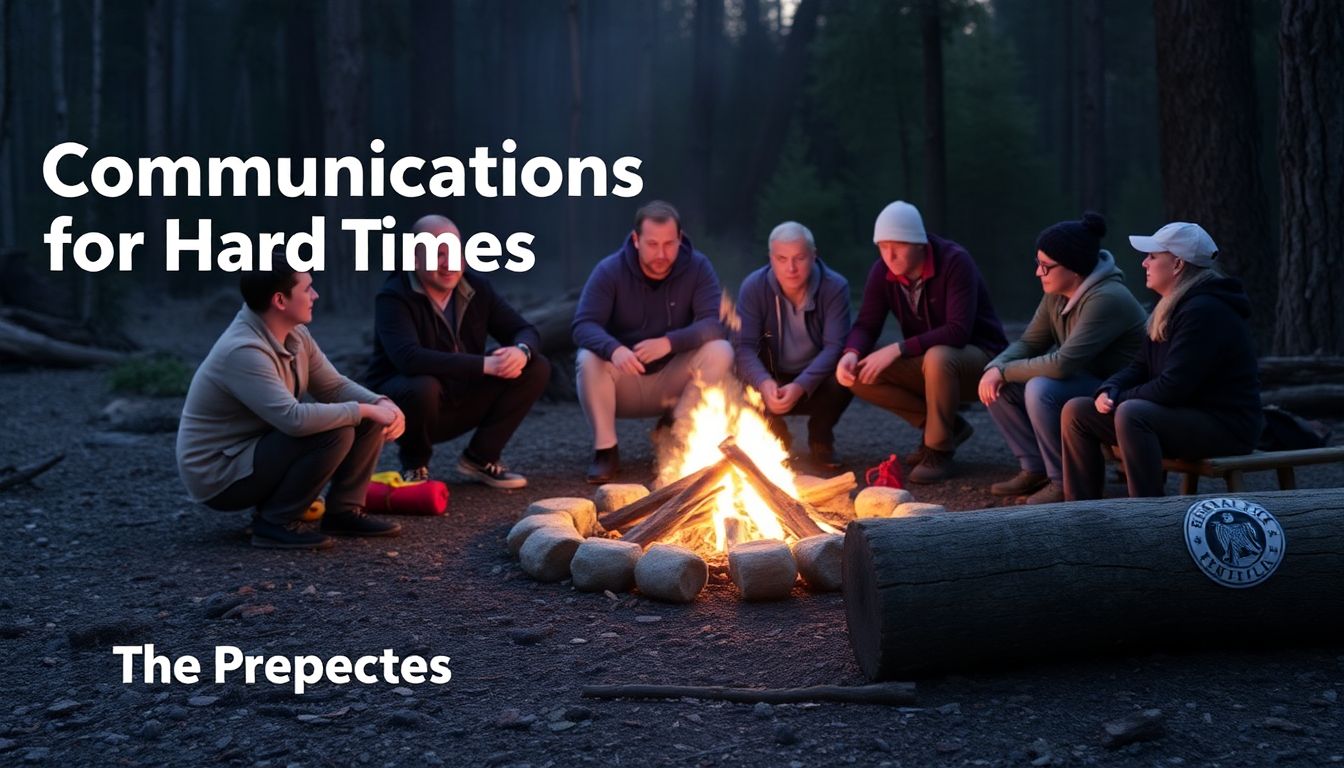
Building Community: Networking and Communication
In the vast expanse of life’s journey, one truth stands out as a beacon of resilience and success: the power of community. This is especially true in survival situations, where the collective strength, knowledge, and support of a group can mean the difference between thriving and merely surviving. Networking and communication, the twin pillars of community building, are not just nice-to-haves but necessities in times of adversity.
The importance of these skills is underscored by works like ‘Communications for Hard Times’ by Tom Chatham and ‘The Preparedness Family’ by Jim Cobb. These guides delve into the intricacies of establishing and maintaining communities, highlighting the critical role of networking and communication.
Networking, in this context, is not about amassing business cards or increasing one’s social media following. It’s about forging meaningful connections with like-minded individuals who share your values and goals. It’s about finding people with complementary skills
- the farmer, the doctor, the engineer, the teacher
- and understanding how their expertise can benefit the community as a whole.
Effective communication is the lubricant that keeps this network running smoothly. It’s about listening as much as speaking, understanding different perspectives, and fostering a sense of unity. It’s about using clear, concise language to convey information, and being open to feedback and criticism. It’s about using every tool at your disposal
- from face-to-face conversations to ham radios, from smoke signals to social media
- to ensure that everyone is informed and involved.
Building a community is not a one-time task but an ongoing process. It requires constant nurturing, adaptation, and growth. It requires a willingness to learn, to teach, and to compromise. It requires a shared vision of the future and a collective commitment to making that vision a reality.
In essence, networking and communication are not just about survival; they are about creating a life worth surviving for. They are about building not just a community, but a family. And that, in the end, is what makes life worth living.
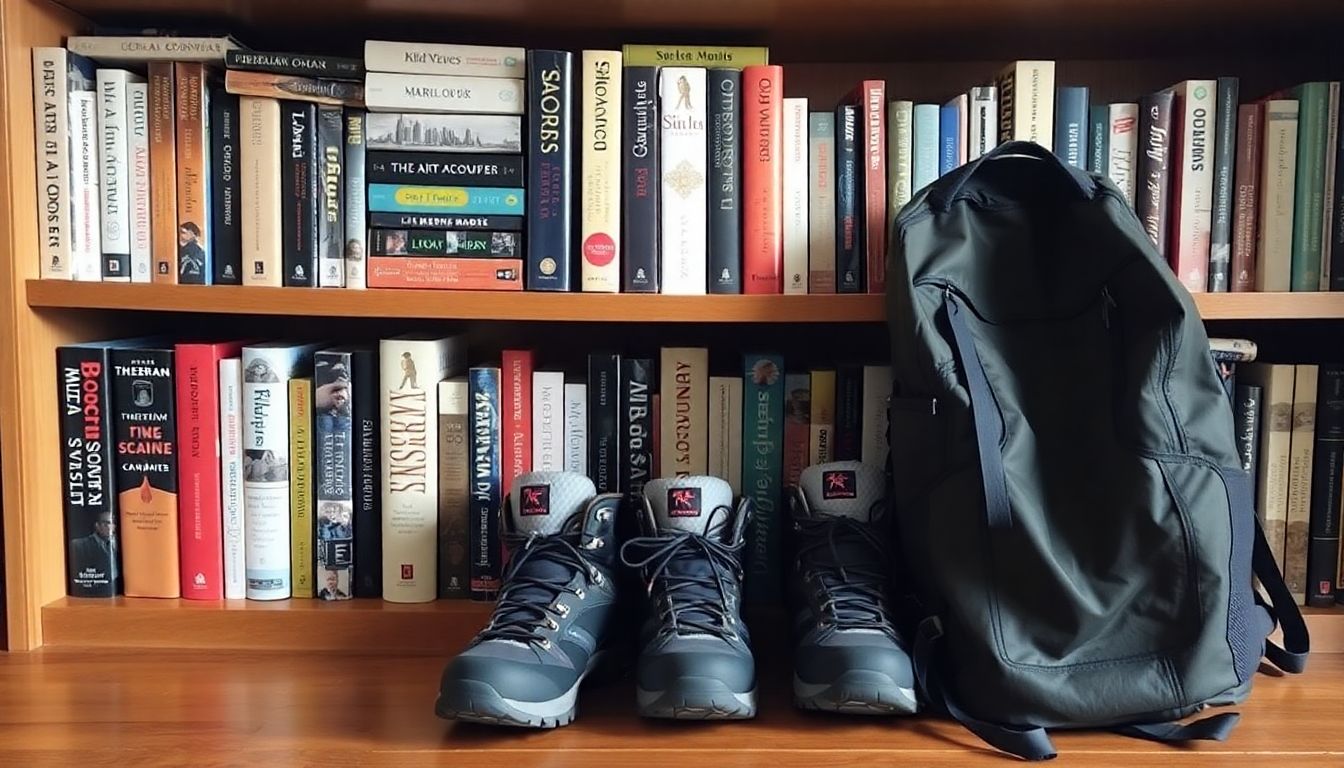
The Art of Resilience: Biographies and Memoirs
In the vast landscape of literature, biographies and memoirs often serve as beacons of hope and inspiration, especially when they chronicle tales of survival and resilience. Take, for instance, Gary Paulsen’s ‘Hatchet’ and Joe Simpson’s ‘Touching the Void’. These narratives, though vastly different in context, share a common thread of human tenacity in the face of adversity.
‘Hatchet’, a young adult novel, tells the story of Brian Robeson, a 13-year-old boy who must survive in the Canadian wilderness after a plane crash. Paulsen’s own experiences of living off the land in Minnesota infuse the story with an authenticity that makes Brian’s struggles all the more compelling. The book illustrates the power of resourcefulness, determination, and adaptability, teaching readers that even in the most dire circumstances, one can find the strength to endure and overcome.
On the other hand, ‘Touching the Void’ is a gripping memoir that recounts Joe Simpson’s near-fatal climbing accident in the Peruvian Andes. Trapped in a crevasse with a shattered leg, Simpson’s will to live is tested to its limits. His account is a testament to the human spirit’s capacity to endure pain, fear, and despair. The book underscores the importance of mental fortitude, highlighting how our minds can push our bodies beyond what we thought possible.
Both these works demonstrate that resilience is not about never falling, but about rising each time we fall. They remind us that we are capable of more than we know, and that even in the darkest moments, there is always a glimmer of hope. By sharing these real-life stories, biographies and memoirs like ‘Hatchet’ and ‘Touching the Void’ inspire readers to embrace their own struggles, to learn from them, and to grow stronger.
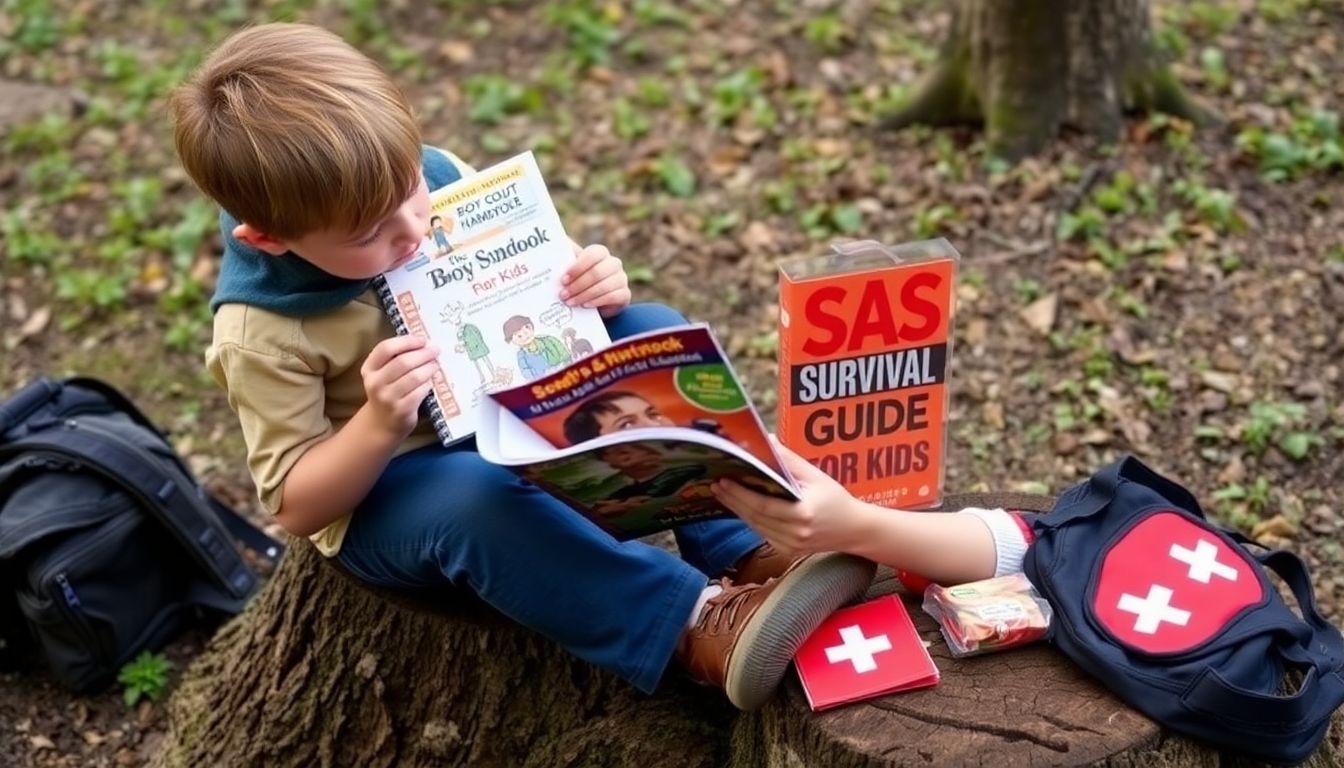
Educating the Next Generation: Survival for Kids
In the ever-evolving landscape of childhood education, there’s a unique niche dedicated to equipping young minds with skills that transcend the classroom. Survival books for children, such as ‘The Boy Scout Handbook’ and ‘The SAS Survival Guide for Kids’, are not just exciting reads but powerful tools that instill essential life skills at a tender age.
The Boy Scout Handbook, a time-honored classic, introduces children to the world of scouting, where learning by doing is the norm. From tying knots to building fires, from navigating trails to providing first aid, this book encourages hands-on learning. It fosters a sense of self-reliance and teamwork, teaching children that they can overcome challenges and contribute to their communities.
On the other hand, ‘The SAS Survival Guide for Kids’ brings the expertise of the elite Special Air Service to young readers. This book doesn’t just teach survival skills; it ignites curiosity and adventure. It covers a wide range of topics, from understanding weather patterns to building shelters, from finding water sources to signaling for help. The book’s engaging, illustrated format makes learning fun and interactive.
Both books, in their unique ways, promote critical thinking, problem-solving, and resilience. They teach children to be resourceful, to adapt, and to thrive in different situations. They instill a sense of responsibility and respect for the environment. Moreover, they foster a love for the outdoors, encouraging children to explore, discover, and appreciate nature.
In essence, these survival books for children are not merely guides to physical survival. They are tools for emotional and mental growth. They teach children to face challenges head-on, to learn from failures, and to never give up. They are not just about surviving; they are about thriving. And in the grand journey of educating the next generation, that’s a survival skill worth cultivating.




